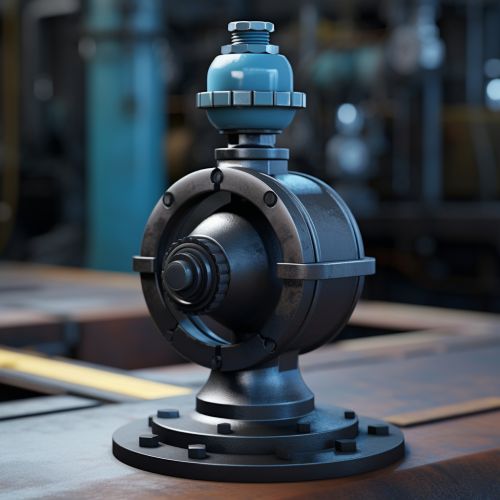Globe valve
Introduction
A Globe valve is a type of valve used for regulating flow in a pipeline, consisting of a movable disk-type element and a stationary ring seat in a generally spherical body. Globe valves are named for their spherical body shape with the two halves of the body being separated by an internal baffle. This has an opening that forms a seat onto which a movable plug can be screwed in to close (or shut) the valve.


Design and Operation
The basic parts of a globe valve are the body, the bonnet, the stem, the disk, the seat ring, and the handwheel or actuator. The body of the valve, often made of cast iron, ductile iron, cast steel, stainless steel, and alloy steels, provides the main structure and contains the internal parts of the valve. The bonnet, which may be screwed into or bolted to the body, provides the enclosure for the stem. The stem, which connects the disk to the actuator, transmits motion from the actuator to the disk. The disk, connected to the stem, is the element that opens or closes the valve. The seat ring, which is pressed into the body, provides the seating surface for the disk. The handwheel or actuator, attached to the stem, is used to open or close the valve.
The operation of a globe valve is straightforward. When the handwheel or actuator is turned in one direction, the stem moves the disk away from the seat ring, allowing fluid to flow through the valve. When the handwheel or actuator is turned in the opposite direction, the stem moves the disk towards the seat ring, stopping the flow of fluid.
Types of Globe Valves
There are three primary types of globe valves, classified by the direction that fluid flows through them: Z-type, Y-type, and Angle-type.
Z-Type Globe Valve
The Z-type globe valve is the most common type of globe valve. In a Z-type globe valve, the stem and disk move at a right angle to the axis of the pipe. This design has the advantage of being simple and reliable, but it also has a high pressure drop due to the flow path.
Y-Type Globe Valve
The Y-type globe valve has a seat and stem at an angle of approximately 45 degrees to the pipe axis. This design reduces the pressure drop compared to the Z-type globe valve and is used in high-pressure and high-temperature systems.
Angle-Type Globe Valve
The Angle-type globe valve is a type of globe valve where the flow path follows a straight line, but the body of the valve is angled at 90 degrees. This design combines the advantages of the Z-type and Y-type globe valves, with a simpler flow path and reduced pressure drop.
Applications
Globe valves are used in a variety of applications, including industrial, residential, and commercial settings. They are particularly useful in applications where flow needs to be regulated or throttled, such as in a faucet or in a gas or liquid service line. They are also used in applications where a valve needs to be shut off frequently, such as in a sampling line.
Advantages and Disadvantages
Like all valves, globe valves have both advantages and disadvantages.
Advantages
Globe valves are excellent for regulating flow. They can be positioned to precise levels, allowing for detailed control of flow. They also provide a good shut-off capability. Globe valves are also easy to resurface in line, which can extend their service life.
Disadvantages
The main disadvantage of globe valves is the high pressure drop in the valve due to the design. This can lead to a loss of efficiency in the system. Globe valves are also larger and heavier than other types of valves, which can be a consideration in some applications.
